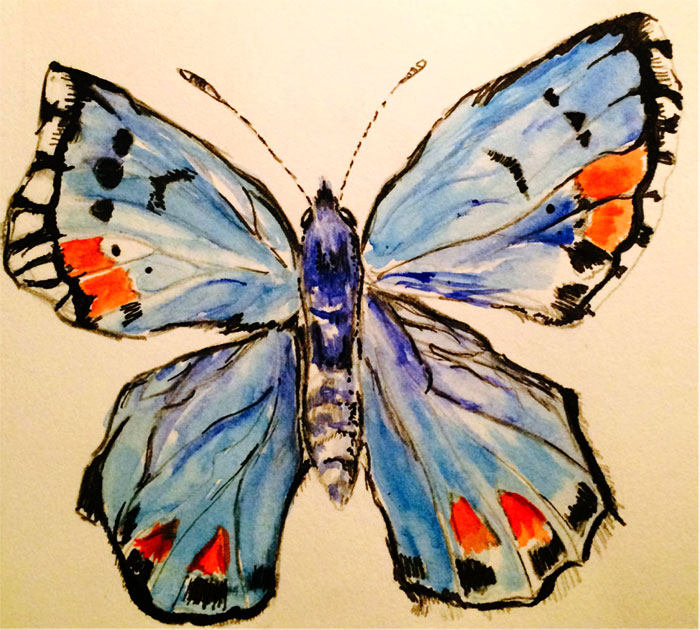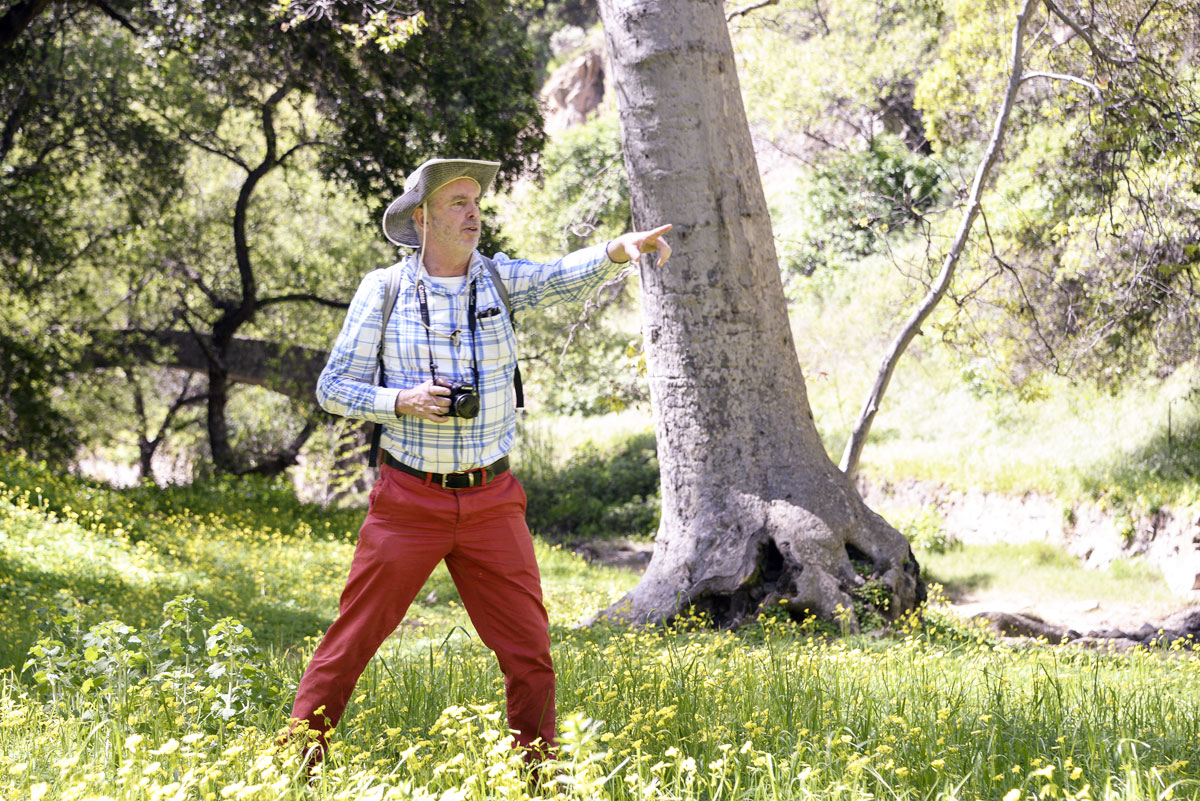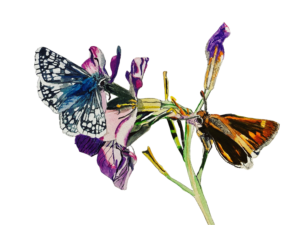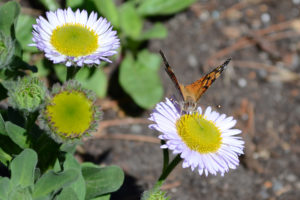The butterfly searchers and I have seen hundreds of butterflies on the wing today, but not yet the one we are searching for: the Sonoran blue. The Sonoran Blue is, according to some experts, the most beautiful butterfly in the Bay Area. Alum Rock Park in San Jose is the best place to find them, and even here it’s not easy. “We like the blues since they’re difficult,” lepidopterist Bill Shepherd tells me. “They’re on the hills that crumble under your feet as you try to get a closer look, they’re small, and you never know quite what to expect.”
Shepherd is part of a diverse group of nature-lovers hunting for the Sonoran Blue butterfly today as part of a walk organized by the California Center for Natural History and led by lepidopterist Liam O’Brien. Unsurprisingly, it is O’Brien who finally finds the butterfly.
“We got it!” he shouts, striking a pose, two fists up in the air in triumph. The walkers cheer as they scramble along the narrow path to see the tiny creature fluttering weakly down the hill. There a lone Sonoran blue, wings flickering an electric azure, wafts over native poppies at the close of its mating season.
There are several species of blue butterflies in the Bay Area. Catching a glimpse of the bright Sonoran, I understood why we had spent so much time and energy looking for one tiny creature. Unlike their counterparts, Sonorans sport brilliant red-orange spots on the forewing and a brilliant blue shine. In females, matching red spots adorn the hindwing as well. Like many species, males actively patrol for females throughout their short lifespan. They float over craggy outcroppings, banks, and cliffs with their tell-tale weak flight. Males can often be spotted floating down a sloped hill in the hopes of finding a mate, only to rise back up and meander down the slope again—like the one we saw.

Place is of utmost importance to the Sonoran blue, as its populations rarely travel to other areas. Extremely local, it is found only in specific pockets in the Bay and south along the coast to Baja. (A subspecies in the upper San Gabriel River went extinct when its home was destroyed in 1969, showing just how vulnerable the butterflies are to habitat destruction.) The Sonoran blue’s distinct colonies led to the rapid creation of “ecotypes” specifically evolved for particular environments. These ecotypes specialize on native host plants and ultimately may form distinct species. This process continually raises new challenges to the identification and classification of the plethora of butterflies in the Bay Area.
The hills above Alum Creek are dotted with a succulent called Dudleya, which the Sonoran blue calls home. Female Sonorans lay a single egg on the host plant. As a caterpillar, the Sonoran blue lives inside the leaves of the plant, which provide it food and shelter. In this stage it shares a symbiotic relationship with Tapinoma sessile, more commonly known as the stink ant. The ants stimulate the caterpillar to release a sweet nectar, called honeydew, by stroking the larva with their legs. This sugar-saturated nectar, a by-product of the larvae’s digestion, provides high-energy food for the ant. In return, the ants protect their life-giving larvae by warding off pests such as parasitic wasps. When it is ready to pupate the caterpillar tucks itself away near the base of the plant and waits for nine months while the Dudleya shrivels. Finally, the butterfly emerges. It is the first non-hibernating butterfly in the Bay Area to do so—as early as January.
Our trip, in April, is late in the season for Sonoran blues. So as we walk through the park, O’Brien calls out the other butterflies he sees: “Azure!” “Sarah Orange-tip!” “Ringlet!” When the birders in the group pause to work on the proper identification of a warbler, O’Brien jokes that “Butterflies are manageable. Not like birds. Hundreds of species of birds. Birders are weird, butterflyers are cool.”
The Sonoran blue, Philotes sonorensis, is a member of the Lycaenidae family and belongs to Papilionidae, or the “true butterflies.” Many Lycaenidae, like the blues, are relatively small butterflies with fragile-looking, colorful wings. These tough creatures are not as frail as they look; many can be seen flying around with V-shaped cuts taken out of their rear wings, the product of close encounters with predatory birds. This is often attributed to the “false heads” located on the rear of their wings to attract birds to their rear rather than their crucial body. “They’re tough, opportunistic creatures,” O’Brien says.
The iridescence of the Lycaenidae is attributed to the intricate pattern of scales along their wings, which act to diffract light reflected off of them. Many butterfly species have taken this one step further, developing an elaborate diffraction grid system to reflect light prismatically. Because butterflies see in the UV spectrum, these diffraction grids are designed primarily to reflect UV light. While we may see some species in one color, the butterflies themselves see each other differently. Looking at species under UV light reveals heightened complexities and ranges of colors invisible to the naked eye. The male Orange Sulphur, for example, identified by its trademark orange pigment color, becomes purple under UV light. Moreover, no two butterflies’ scale patterns are exactly the same, much like human fingerprints, and environmental factors such as temperature influence the exact pattern of scale development. These effects are especially noticeable on the Sonoran blues, whose electric blue wings draw enthusiasts like us from around the Bay Area. To see one flitting gently down the hill, its wings shining, is both a fleeting gift of beauty, and an exhortation to return to see it again, when the butterfly, and the gift, will be different.
Correction: An earlier draft of this story incorrectly reported the number of species of butterflies in the Bay Area. There are 32 in San Francisco, and more than 60 in the greater Bay Area.





